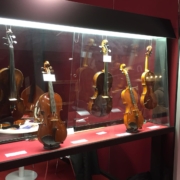When buying a violin
More Things to Consider when buying a violin
For violins and violas, there is one sound you will hear under your ears; a second the instrument produces when someone hears from a relatively close distance; and a third listeners will hear in a concert hall. This tone can be darker or brighter and more or less powerful in all three situations.
Another factor to keep in mind is the type of playing you do. If you are primarily using your instrument for playing in an orchestra, you should consider how well you are able to hear yourself in comparison to how well you hear your string colleagues – especially in your own section. This can only be determined by testing the instrument in rehearsals and concerts. Ask your dealer if you can take the instrument for a week or so to test it in some of the situations mentioned above.
This situation is not as acute for cellos and double basses, where the sound produced is at a relative distance away from the player’s ears.
Power can be improved by regular soundpost adjustments, upgrading the bridge and modification of the bass bar or top or back. procedures should only be undertaken by a qualified luthier who works exclusively with violin-family instruments.
Finally, one should experiment with strings – some are made expressly to produce a warmer, darker tone, others for a brighter and more brilliant sound. Mixing brands of strings is very common, especially with the E string on violin and the A string on viola and cello. Finally, one can go with a stronger or weaker tension if a particular string needs a boost or reduction – sets or individual strings can be ordered in soft, medium or strong.

